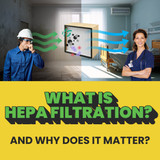Choosing the Right Cleaning Chemical: Stabilised Chlorine Dioxide vs. Hydrogen Peroxide
Selecting the right cleaning chemical is crucial in the professional cleaning and restoration industry. Stabilised Chlorine Dioxide and Hydrogen Peroxide are two commonly used options, each with its unique properties and considerations. In this blog post, we will explore the key factors professionals should keep in mind when deciding between these two chemicals.
The idea for this discussion arose from recognizing the industry's misunderstandings around these chemicals. We initiated a dialogue with Jay, our Occupational Hygienist, who attended our last two flood house courses. His expertise greatly contributed to our understanding of chemical risk assessment and more.
Additionally, after hearing Brett at Coach8's Spring Break & Australasian Indoor Building Management Symposium discuss their use of chlorine dioxide, we felt compelled to delve deeper into this topic and open up the discussion.
Understanding the Chemicals
Stabilised Chlorine Dioxide and Hydrogen Peroxide serve different purposes and have distinct characteristics:
Stabilised Chlorine Dioxide (such as Protox Hysan):
- Primary Use: Cleaning
- Rapid Stabilization: Safe for re-entry within 5 to 10 minutes
- Toxicity: Slightly alkaline and less toxic
- PPE: Minimal protection required
- Grease Cutting: Effective at removing grease
- Material-Friendly: Can treat mould without damaging materials
- Surface Tension Reduction: Eases cleaning by breaking down surface tension
- Dilution: Contains only 1% of the chemical, reducing the risk of skin or eye contact
Hydrogen Peroxide (such as Protox HP18):
- Primary Use: Stain removal
- Duration of Activity: Remains active on surfaces for up to 24 hours (based on concentration levels)
- Toxicity: Acidic nature (pH around 6) can make it hazardous
- PPE: Requires good quality reusable chemical gloves and eye wash stations
- Skin and Eye Hazard: Can damage skin cells and eye retinas on contact
- Surface Damage: Acidic component can etch into surfaces, potentially causing lasting damage
- High Concentration: Most hydrogen peroxide chemicals have a concentration of 10% to 30%, making them highly concentrated and potentially more dangerous upon prolonged exposure
Key Considerations for Professionals
- Chemical Risk Assessment: Professionals should conduct a thorough chemical risk assessment for each job, especially when choosing between hazardous and less hazardous chemicals. This helps in correctly identifying and using appropriate PPE.
- Workplace Health and Safety: Adherence to Workplace Health and Safety laws requires reducing risks associated with chemical usage. Choosing a less toxic chemical whenever reasonable enhances safety.
- Surface Compatibility: Consider the materials being cleaned. Stabilised Chlorine Dioxide is known for being material-friendly, while Hydrogen Peroxide's acidic nature may cause damage. Spot tests are always a good idea to determine when is safe to use a more acidic chemical.
- Duration of Exclusion: Depending on the chemicals' activity duration, you may need to exclude customers and staff from treated areas for varying periods.
- PPE: Evaluate the PPE requirements. Stabilised Chlorine Dioxide generally requires minimal protection, while Hydrogen Peroxide necessitates more extensive precautions.
- Skin and Eye Safety: Hydrogen Peroxide poses a higher risk to skin and eye safety, requiring a well-equipped first aid response.
- Concentration Levels: Hydrogen Peroxide's high concentration levels can be a concern for prolonged exposure, making careful handling crucial.
When it comes to choosing between Stabilised Chlorine Dioxide and Hydrogen Peroxide in the professional cleaning and restoration industry, a thorough understanding of the unique properties and a comprehensive risk assessment are essential. While both chemicals can effectively serve their purposes, safety considerations often lead professionals to opt for Stabilised Chlorine Dioxide due to its lower toxicity and reduced risks. Prioritizing safety is paramount to success in this industry. When looking specifically at both as cleaning chemical, it is important to note that with agitation stabilised chlorine dioxide will physically remove dirt and grease from the surfaced compared to hydrogen peroxide that requires agitation, wiping and vacuum to remove from the surface.
Recent Posts
-
What Is HEPA Filtration and Why Does It Matter?
In today’s world, air quality isn’t just a comfort—it’s a health and safety …2nd Jul 2025 -
The Trotec TAC Commercial Air Cleaner Range Has Landed in Australia
In industries where indoor air quality isn’t just a comfort—it's a requirement—the …13th Jun 2025 -
Claim the $20K Instant Tax Write Off Before 30 June 2025
For small business owners in Australia, there's an intelligent tax deduction opportunity that you de …19th May 2025




